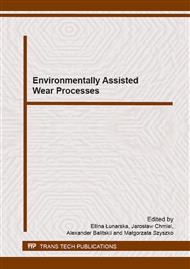[1]
M.F. Ashby, S.C. Lim, Wear-mechanism maps, Scripta Metallurgica et Materialia 24 (1990) 805-810.
DOI: 10.1016/0956-716x(90)90116-x
Google Scholar
[2]
I. M Hutchings, Ductile-brittle transitions and wear maps for the erosion and abrasion of brittle materials, Journal of Physics D: Applied Physics 25 (1992) A212-A221.
DOI: 10.1088/0022-3727/25/1a/033
Google Scholar
[3]
M.M. Stack, N. Corlett, A. Zhou, A methodology for the construction of the erosion-corrosion map in aqueous environments, Wear 203 (1997) 474-488.
DOI: 10.1016/s0043-1648(96)07386-3
Google Scholar
[4]
J. Jiang J., M.M. Stack, A. Neville, Modelling the tribo-corrosion interaction in aqueous sliding conditions, Tribology International 35 (2002) 669-679.
DOI: 10.1016/s0301-679x(02)00058-0
Google Scholar
[5]
A. Stachowiak, W. Zwierzycki, Verification of computional model for corrosive and mechanical wear, Eksploatacja i Niezawodność - Maintenance and Reliability 44 (2009) 28-36.
Google Scholar
[6]
A. Stachowiak, W. Zwierzycki, Tribocorrosion modeling of stainless steel in a sliding pair of pin-on-plate type, Tribology International 44 (2011) 1216-1224.
DOI: 10.1016/j.triboint.2011.05.020
Google Scholar
[7]
A. Stachowiak, W. Zwierzycki, Analysis of the tribocorrosion mechanisms in a pin-on-plate combination on the example of AISI 304 steel, Wear 294-295 (2012) 277-285.
DOI: 10.1016/j.wear.2012.07.013
Google Scholar
[8]
A. Stachowiak, W. Zwierzycki, Corrosive and mechanical wear in sliding pairs, Solid State Phenomena 113 (2006) 359-362.
DOI: 10.4028/www.scientific.net/ssp.113.359
Google Scholar
[9]
J.A. Williams, Wear and wear particles - some fundamentals, Tribology International 38 (2005) 863-870.
DOI: 10.1016/j.triboint.2005.03.007
Google Scholar
[10]
M. Stemp, S. Mischler, D. Landolt, The effect of mechanical and electrochemical parameters on the tribocorrosion rate of stainless steel in sulphuric acid, Wear 255 (20030 466-475.
DOI: 10.1016/s0043-1648(03)00085-1
Google Scholar
[11]
Y. Sun Y., Vipul Rana, Tribocorrosion behaviour of AISI 304 stainless steel in 0. 5M NaCl solution, Materials Chemistry and Physics 129 (2011) 138-147.
DOI: 10.1016/j.matchemphys.2011.03.063
Google Scholar


